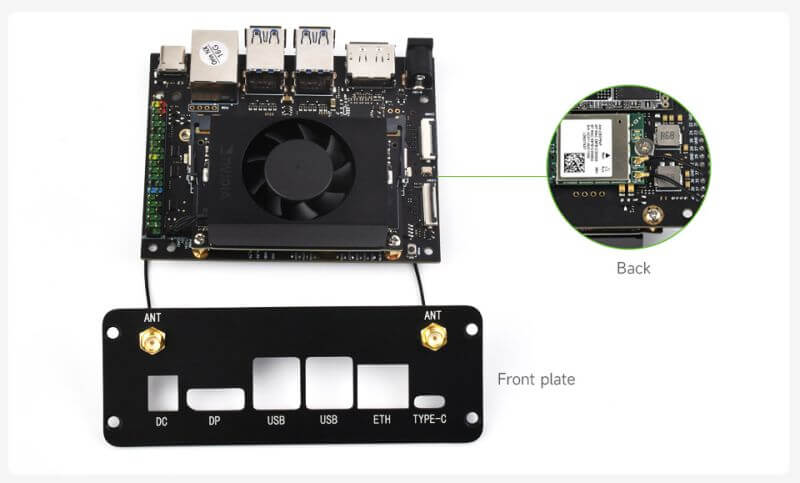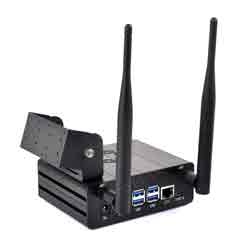- sales/support
Google Chat: zj734465502@gmail.com
- sales
+86-0755-88291180
- sales01
sales@spotpear.com
- sales02
dragon_manager@163.com
- support
tech-support@spotpear.com
- CEO-Complaints
zhoujie@spotpear.com
- sales/support
WhatsApp:13246739196
- HOME
- >
- ARTICLES
- >
- Jetson Series
- >
- Jetson Acc
Jetson Orin Nano JETSON-ORIN-CASE-A User Guide
How to Assemble
- Before assembling, you can first confirm that all the accessories are complete.
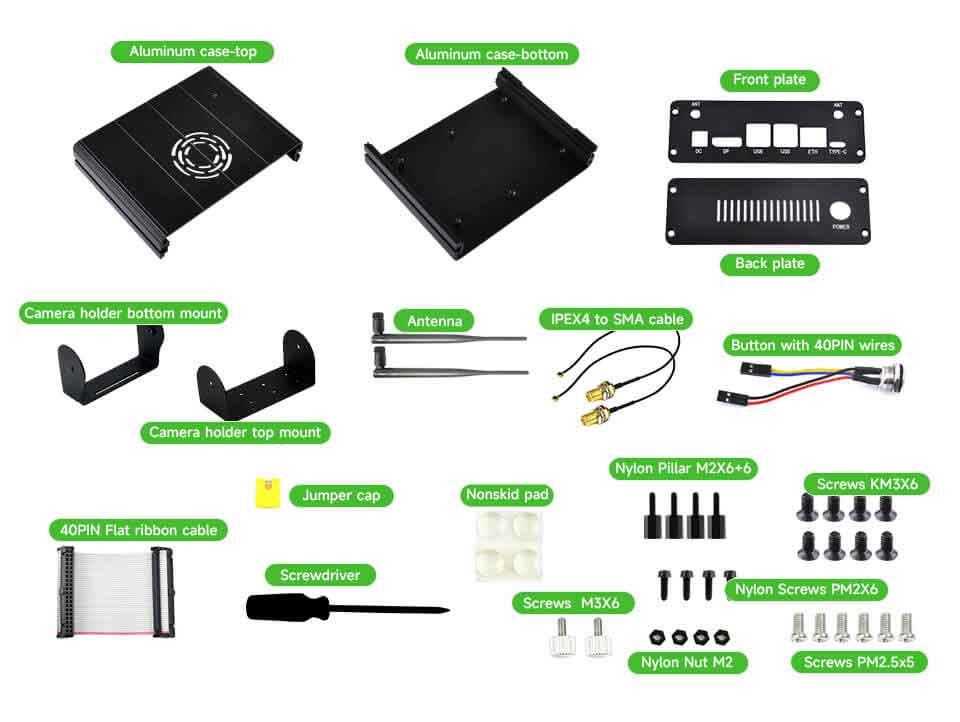
Among them, the list of ⑬ screw packages includes:- Jumper cap
- M3 screws
- M2 nylon pillar
- M2 nylon screws
- M2 nylon nut
- M3 black flat-head screws
- M2.5 silver screws
- Remove the base of the Jetson Orin Nano/NX and also remove the PCB antenna of the wireless card. Please keep the removed parts for future after-sales and service purposes to restore the board when needed.
- Install the IPEX4 to SMA cable to the front plate. To fix the SMA connector, you need to unscrew the fixed nut of the cable and lock it on the outside of the front plate. The other end of the IPEX4 to SMA cable cable is connected to the wireless card on the back.
- Fix the Jetson Orin Nano/NX module to the aluminum bottom case with M2.5 silver screws, and simultaneously fix the front plate to the aluminum bottom plate with M3 black flat-head screws.
- Insert a jumper cap into the AUTO ON and DIS pins on the module. Unscrew the nut with the LED button and secure it to the back plate. Connect the button wires to the PWR BTN/GND and LED pins on the module.
- Note that the red wire should be connected to LED+, the black wire to LED-, and the yellow and blue wires are for the button, with no specific order required.
- After connecting the button, use M3 black flat-head screws to secure the lower part of the back plate to the aluminum bottom case.
- If you need to connect a camera, thread the camera ribbon cable through the hole on the right side, securing it to the camera interface. Ensure that the metal contacts of the ribbon cable are facing downward.
- If you need to connect a camera, secure the camera holder bottom mount to the aluminum top case using M2.5 silver screws.
- If you need to connect a camera, use the provided nylon screw set to secure the camera to the camera holder top mount. Make sure to insert nylon pillars between the camera and the bracket to prevent the camera from short-circuiting.
- Please note that you should not use metal screws in this step. Using metal screws could lead to a short circuit with the camera, potentially damaging the equipment.
- Fix the camera holder top mount onto the camera holder bottom mount and tighten them together using M3 screws. During use, users can loosen the screws to adjust the bracket's angle as needed.
- Install the aluminum top case onto the bottom case, ensuring the correct orientation. Then, use M3 black flat-head screws to securely fasten the upper side of the side panels. Connect the other end of the camera ribbon cable to the camera, and attach the antenna.
- Finally, users in need can apply non-slip rubber pads to the bottom.

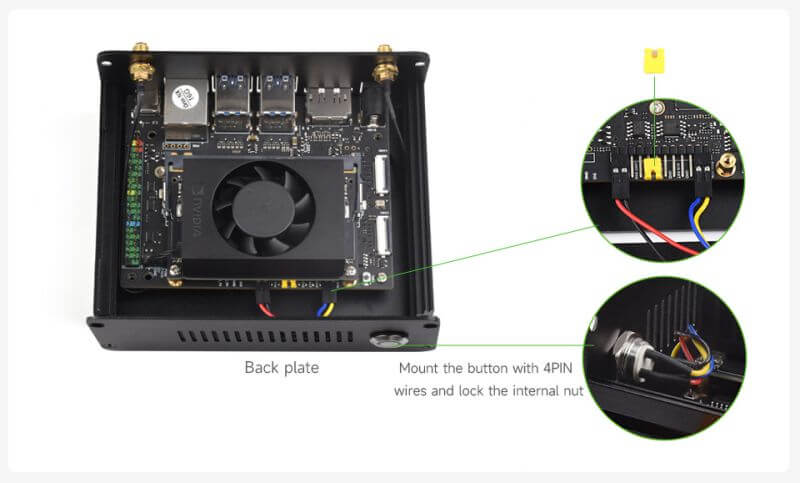
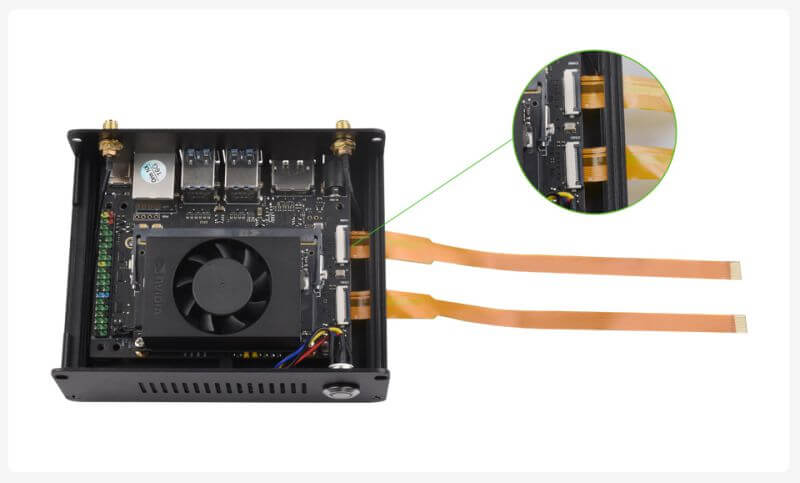
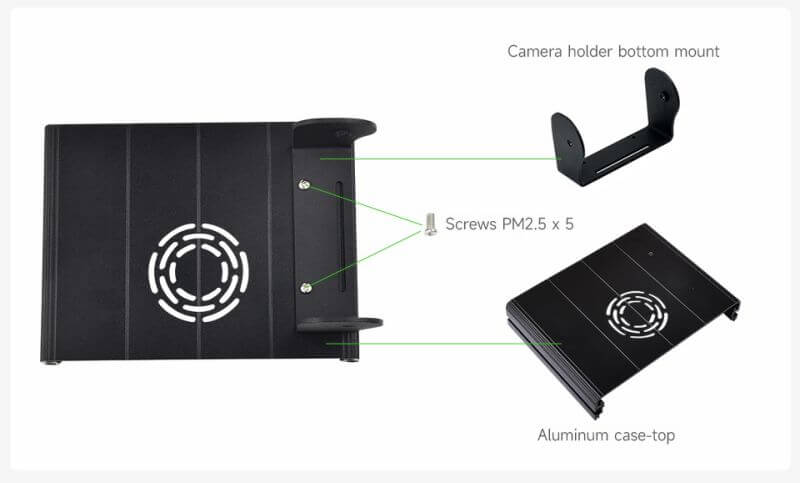

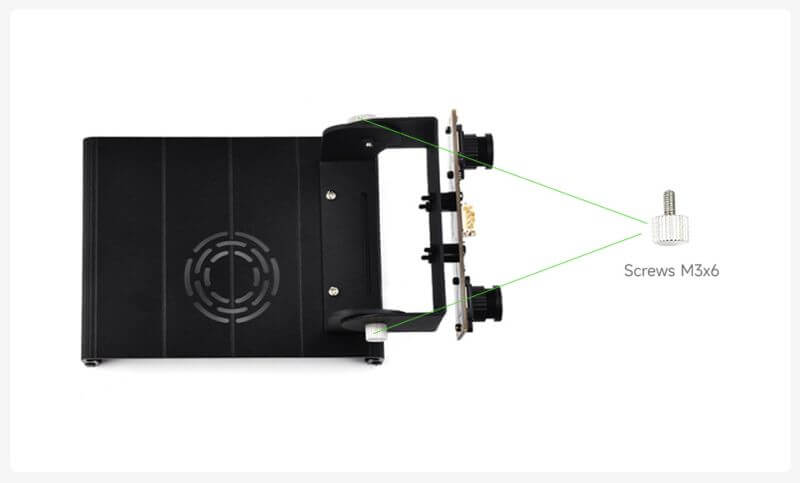


TAG:
USB Camera
OLED-LCD-HAT-A
DeepSeek XiaoZhi AI Chat Robot ESP32-S3 1.54 inch LCD N16R8 MUMA Development Board Display Screen Wifi Weather Station TimeClock
Raspberry-Pi-A7670E-GSM-GPRS-GNSS-LTE-Cat-1-2G-A-User-Guide
SC09 Serial UART Bus Servo Motor Switchable 2.3kg 300Angle
Raspberry Pi ZERO
Raspberry Pi 5 inch LCD 720x1280 Capacitive TouchScreen Display HDMI For Jetson Nano/mini Computer PC
Industrial
ESP32 ST7789
Raspberry Pi 5 Night Camera
Milk-V Duo Wiki
Raspberry Pi UGV Rover ROS2 PT AI OpenCV Robot Car MediaPipe
JETSON NANO MINI
Raspberry Pi 5 Camera
Raspberry Pi 5
Raspberry Pi Mini TV
Milk-V Duo Information
TTL To CAN Mini
Raspberry Pi 1.3inch LCD
Raspberry Pi CM5 Compute Module 5 Development Kit With CM5104032 + Official Original IO Board + Case
TAG:
1.69inch LCD TouchScreen Display 240×280 ST7789 Arduino Raspberry Pi ESP32S3 Pico STM32
Raspberry Pi Pico RP2040 1.69 inch TouchScreen Round LCD Display QMI8658 QST Attitude Gyro Sensor Buzzer RTC PCF85063 Arduino electronic wrist watch
Raspberry Pi 2.8 inch DSI Display MIPI LCD Capacitive TouchScreen 480x640
Luckfox Pico Core1106 RV1106
ESP32 S3 Development Board 1.75 inch AMOLED Display TouchScreen SD slot 6-axis sensor Deepseek
ESP32-S3 Industrial 8-Channel Controller with WiFi Bluetooth CAN IoT RS485 and RJ45 ETH POE
Raspberry Pi 14 inch TypeC Monitor DisplayScreen Computer PC 1920x1200
Rockchip
Raspberry Pi 5 PoE Moudle
DeepSeek AI Voice Chat ESP32 S3 Development Board 1.83 inch TouchScreen Display 240x284
M12 High Resolution Lens 12MP 113 2.7mm Raspberry Pi High Quality Camera M12
Raspberry Pi 5 DSI
Raspberry Pi
0.85inch LCD
PC Monitor Screen
Arducam
Raspberry Pi 5 NVMe
Raspberry Pi 5 ABS Case 3.5inch Display Fan Hole Compatible Multi-Purpose with Removable Cover and Fan Mount
Jetson Nano PWM Fan
Raspberry Pi 5 PCIe to M.2 NVMe SSD




